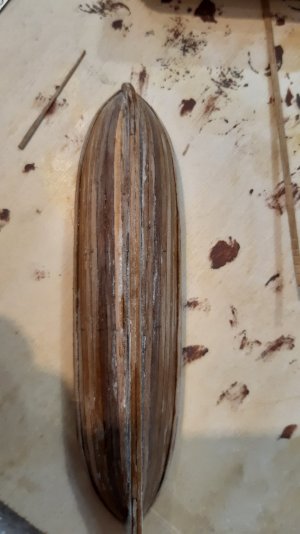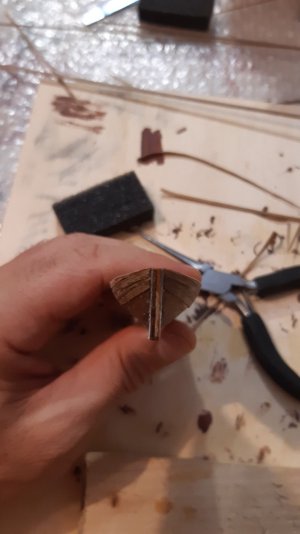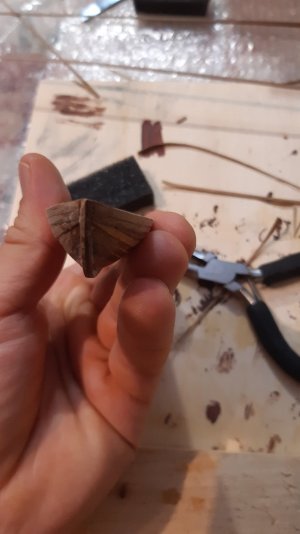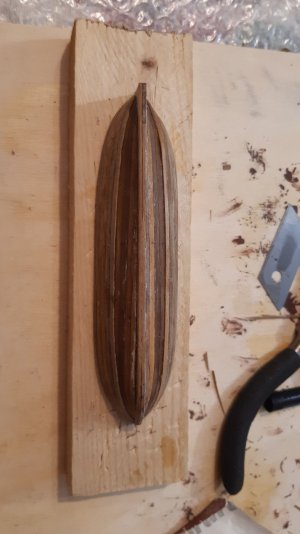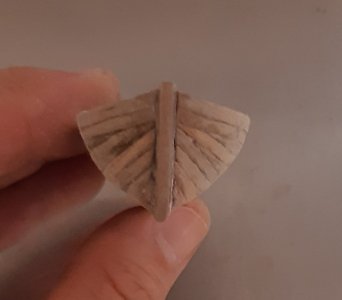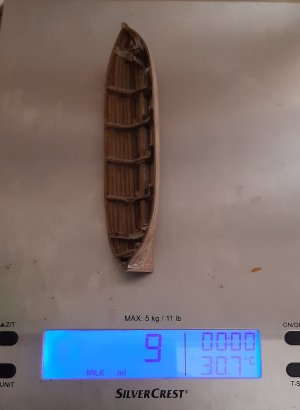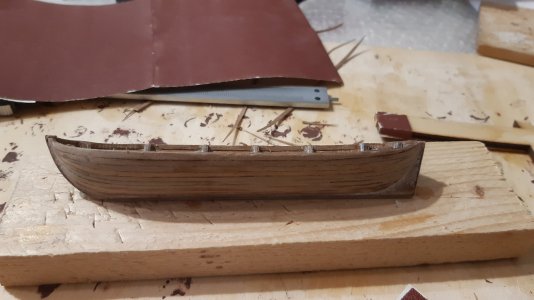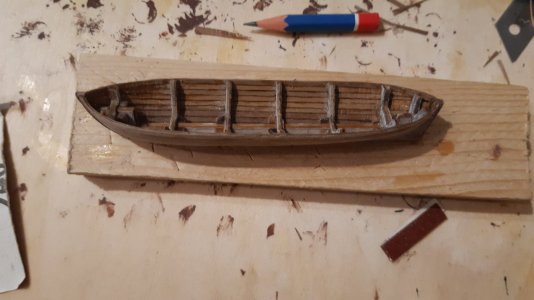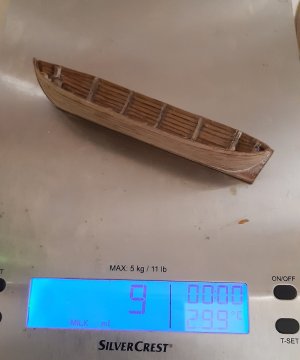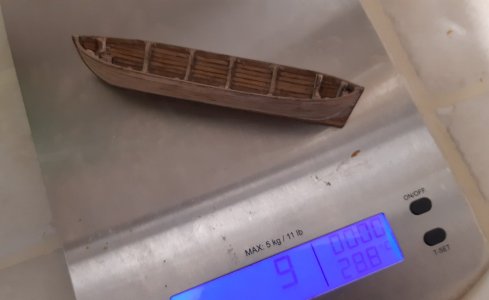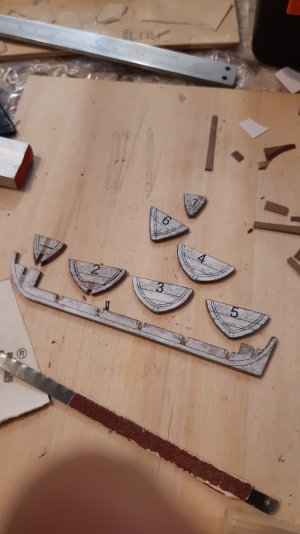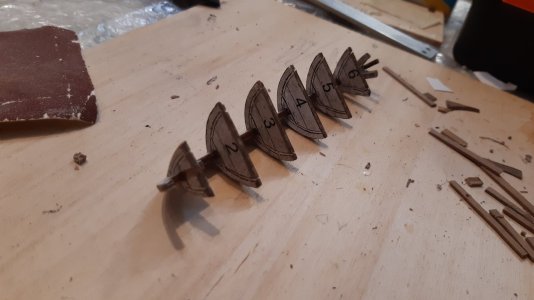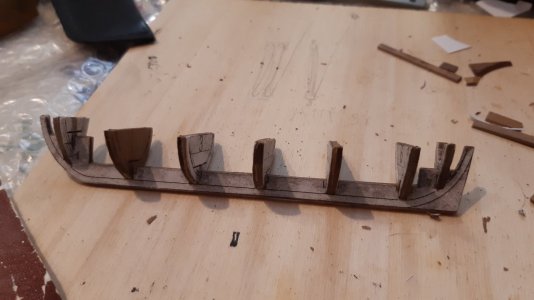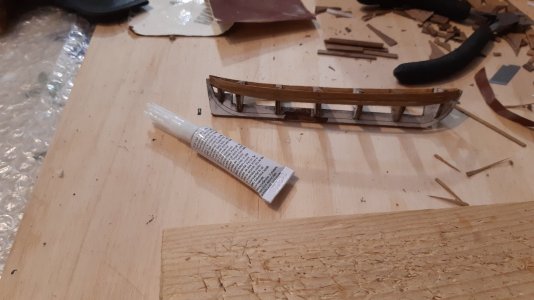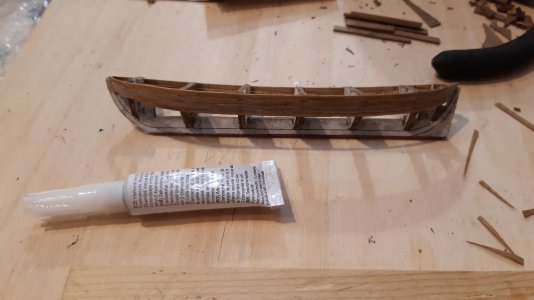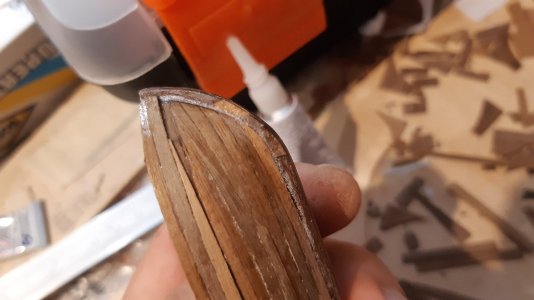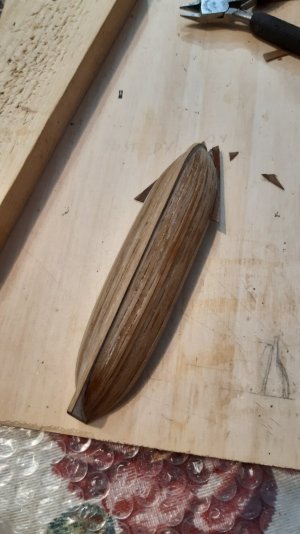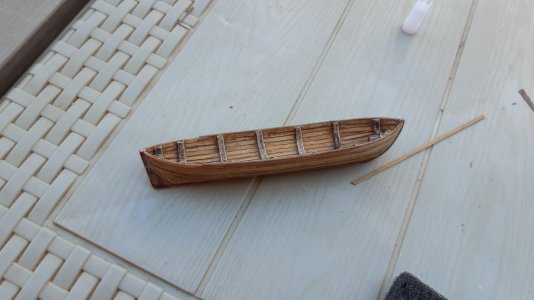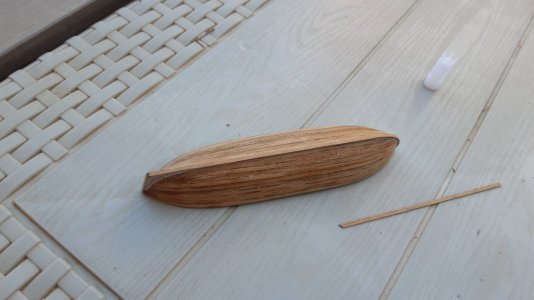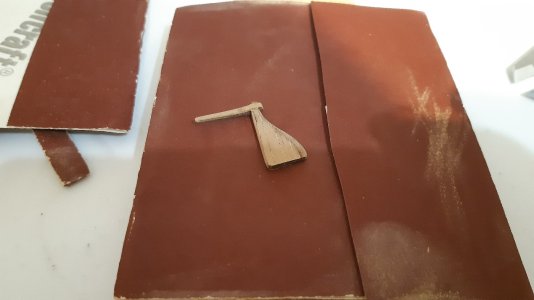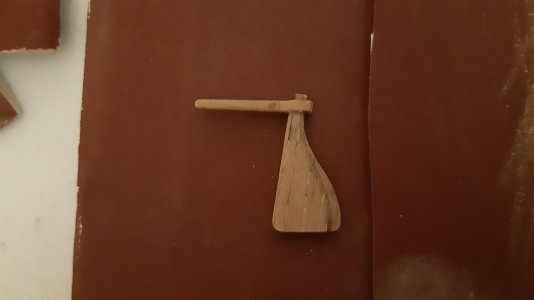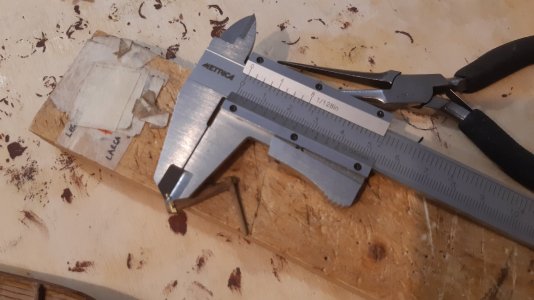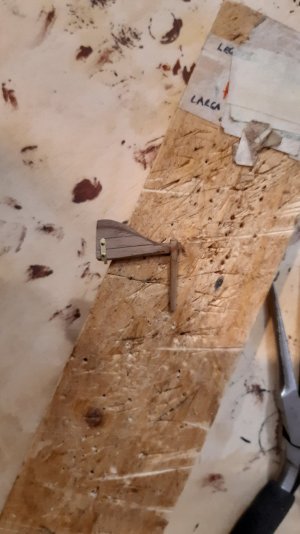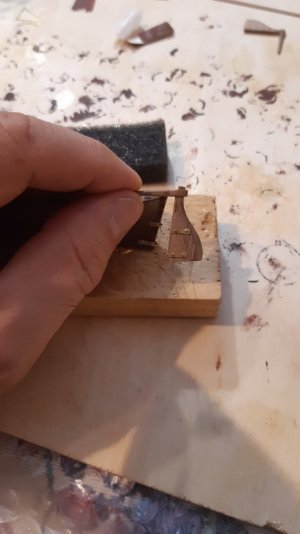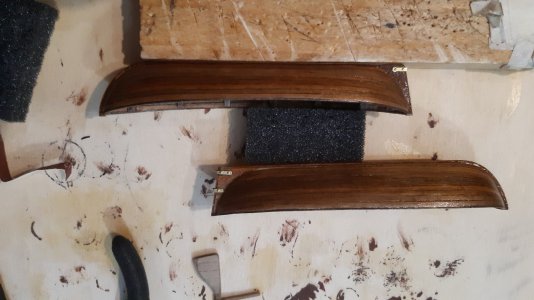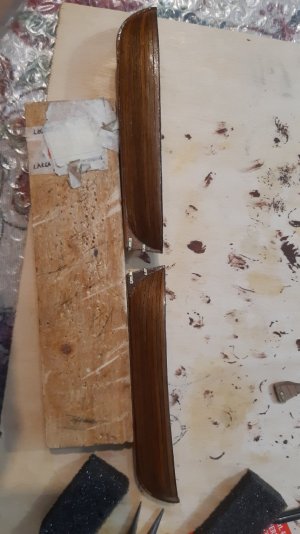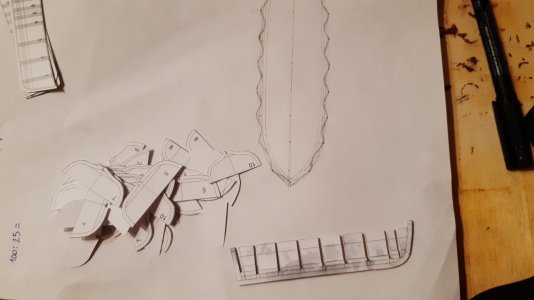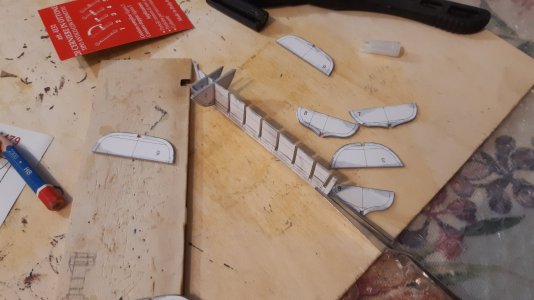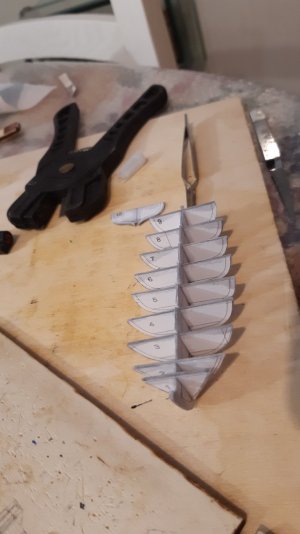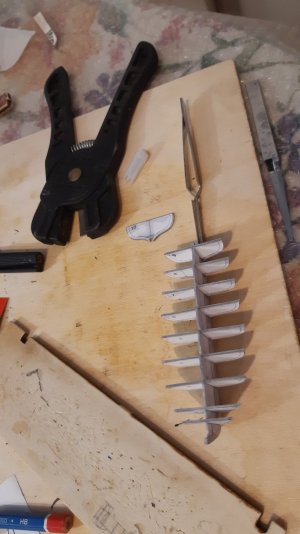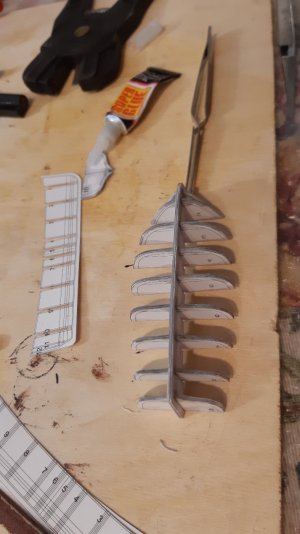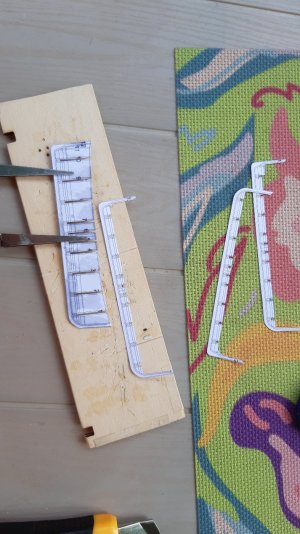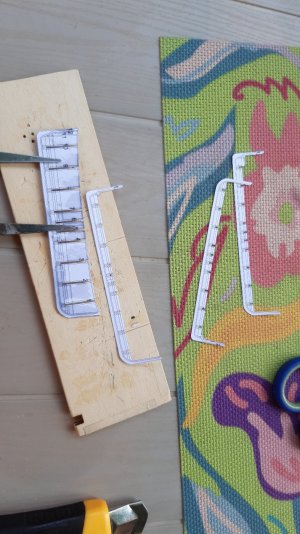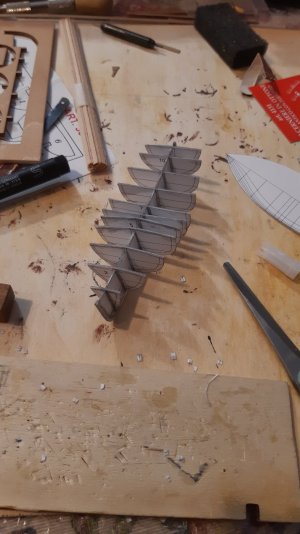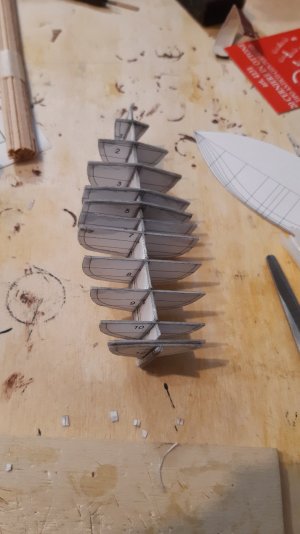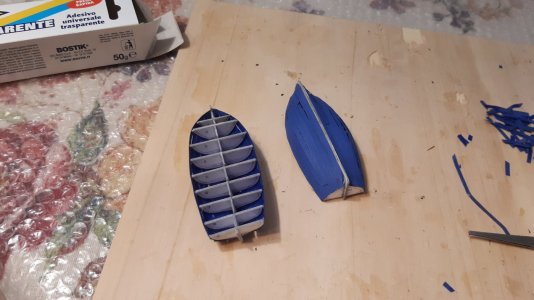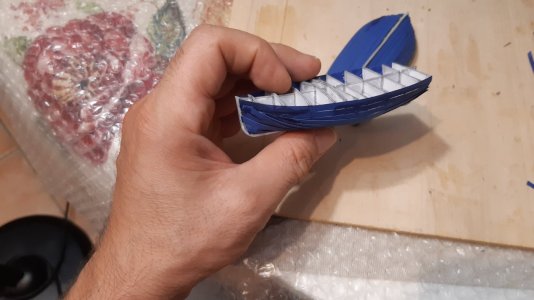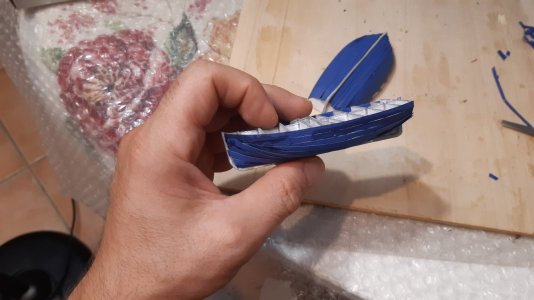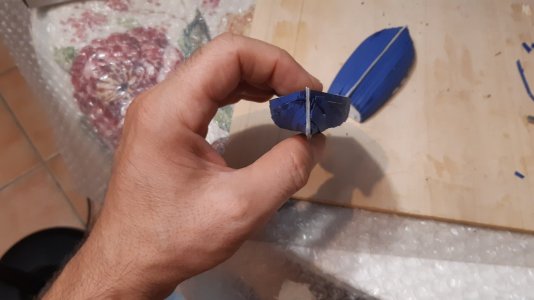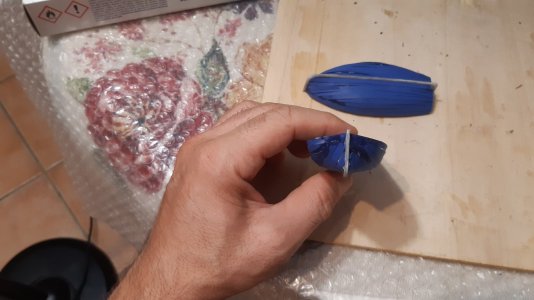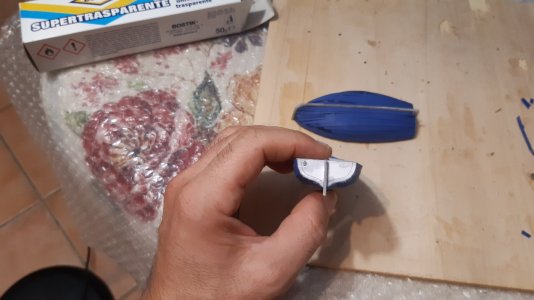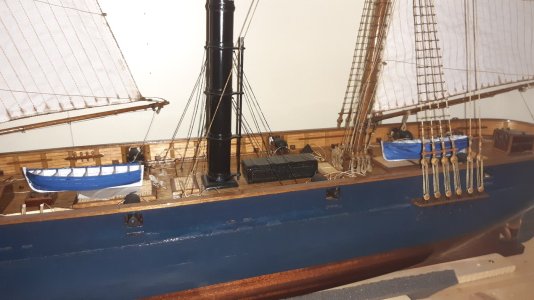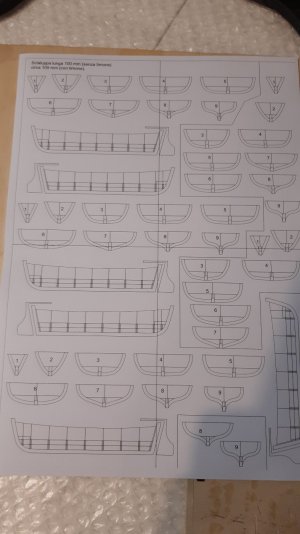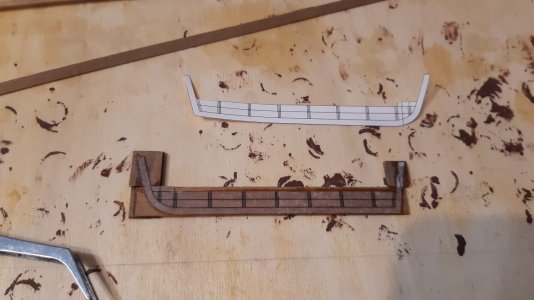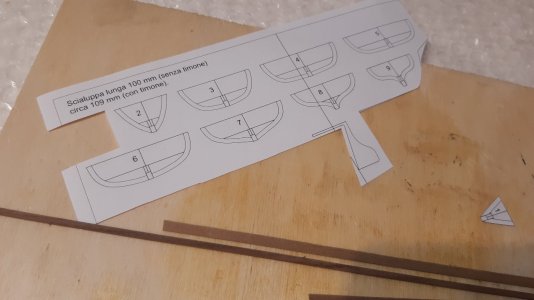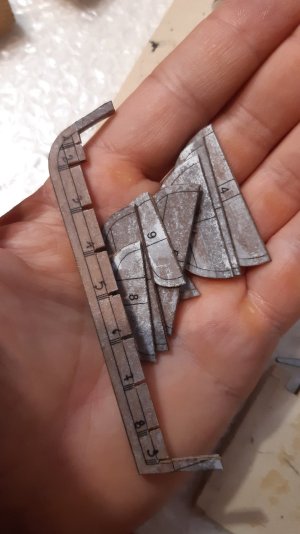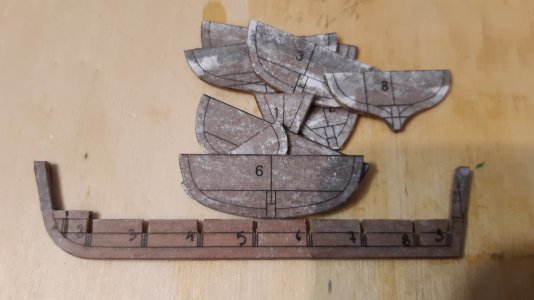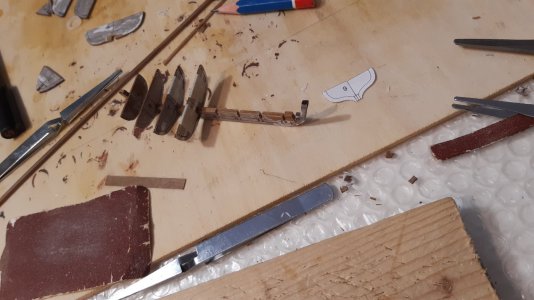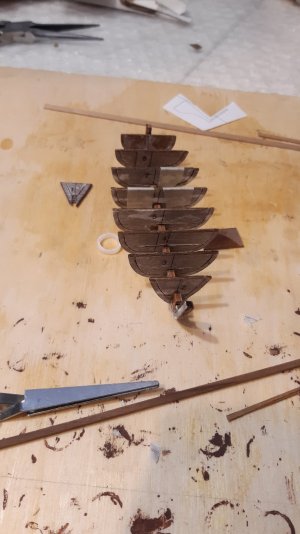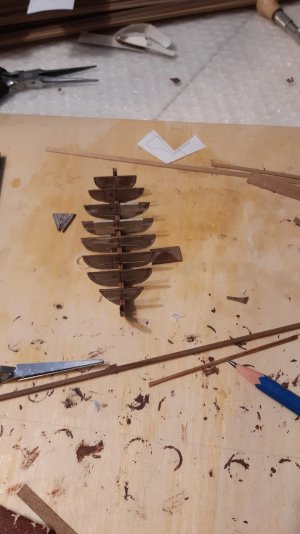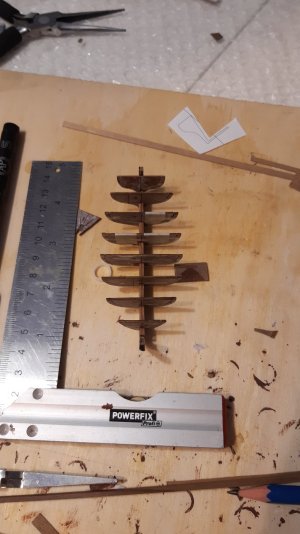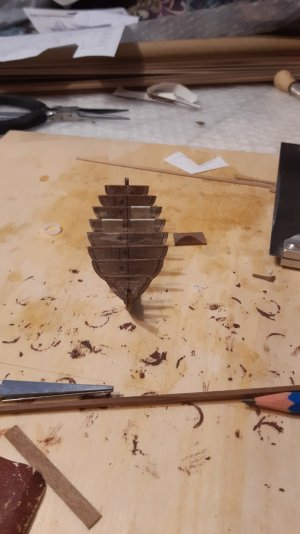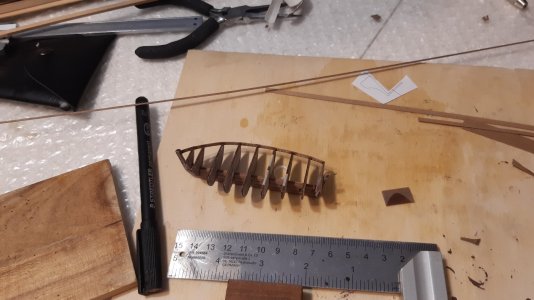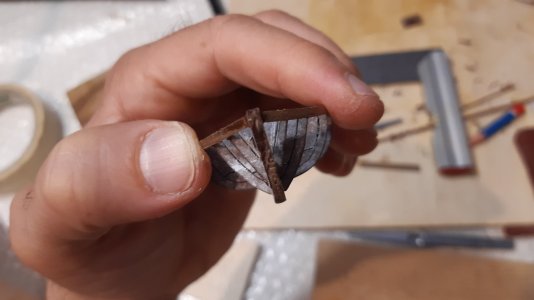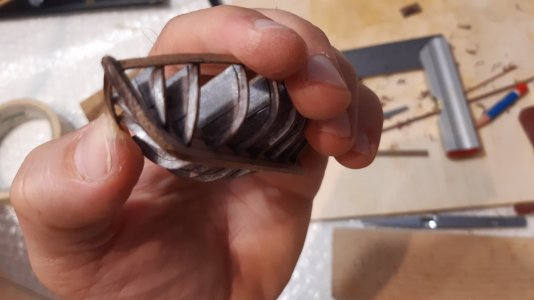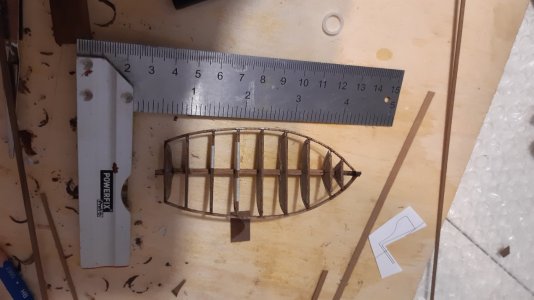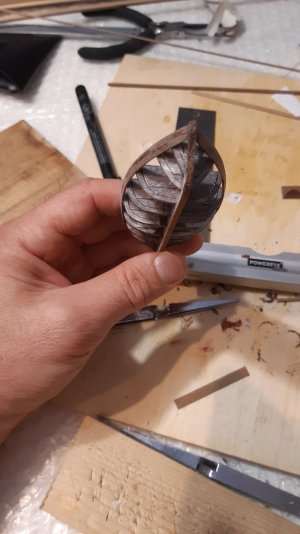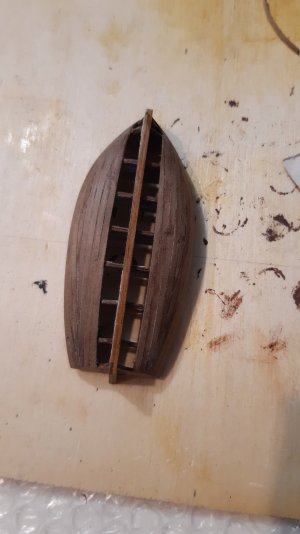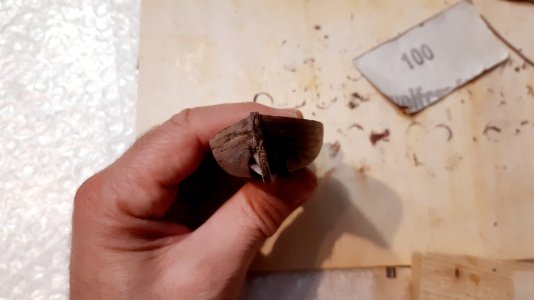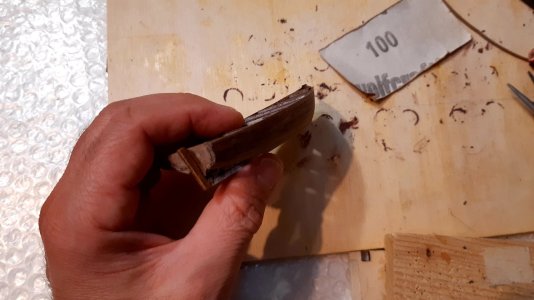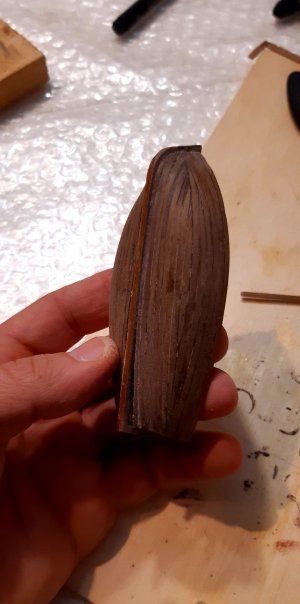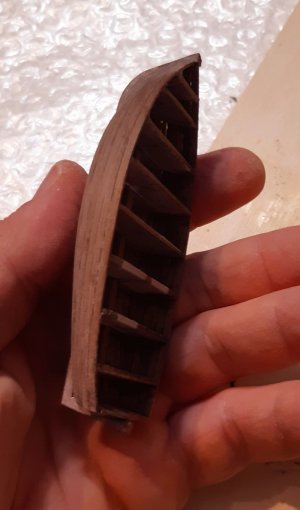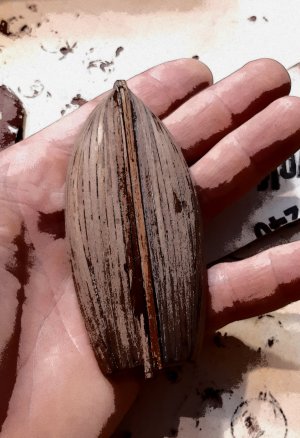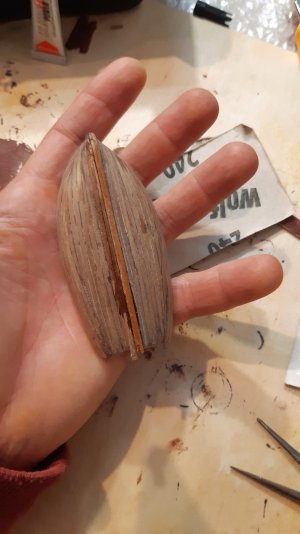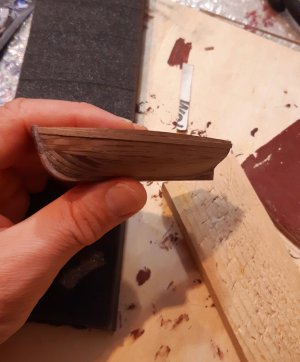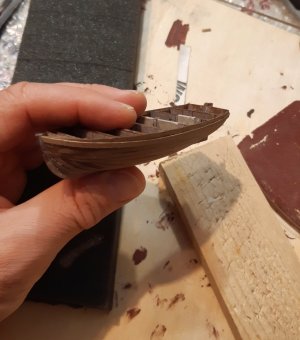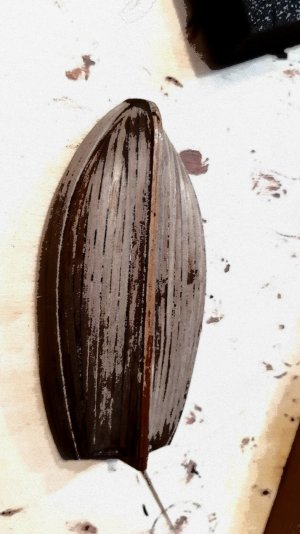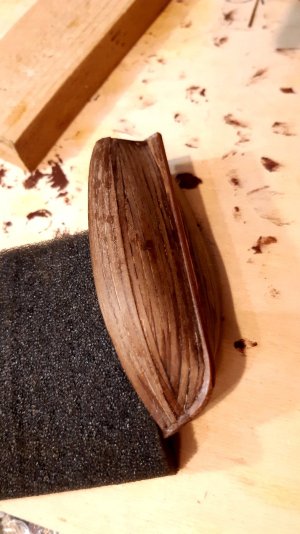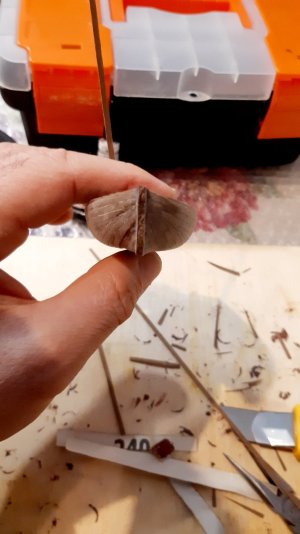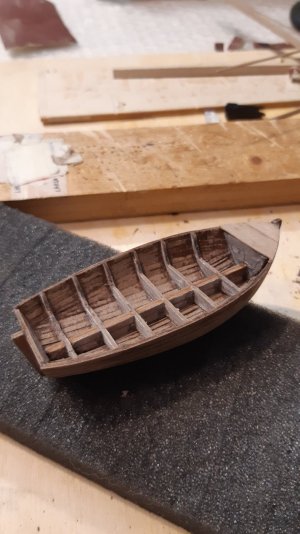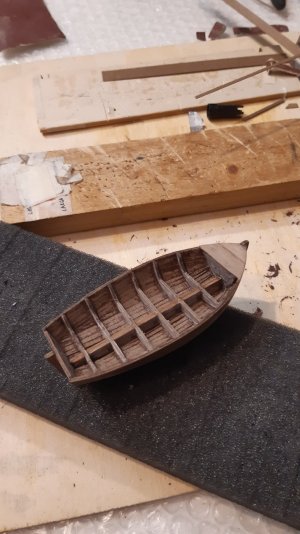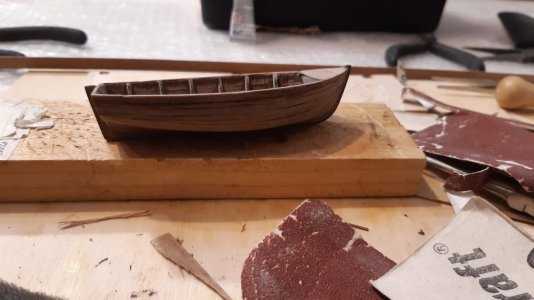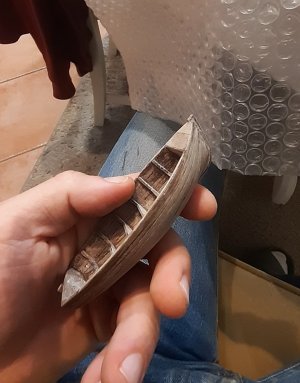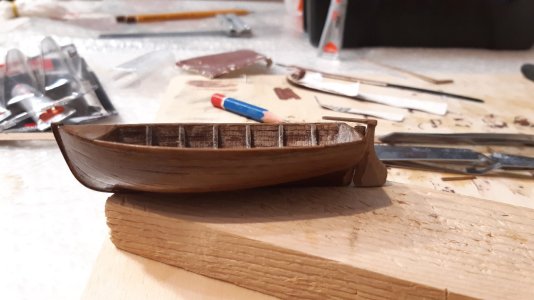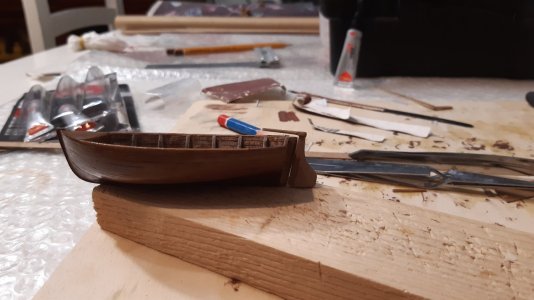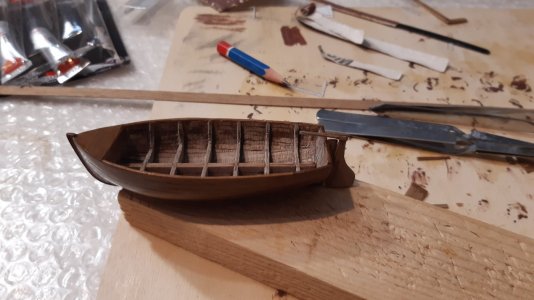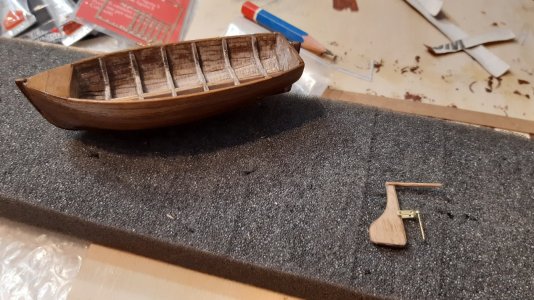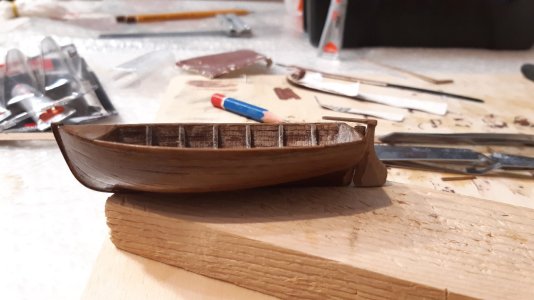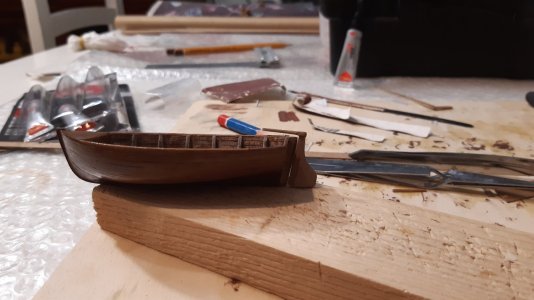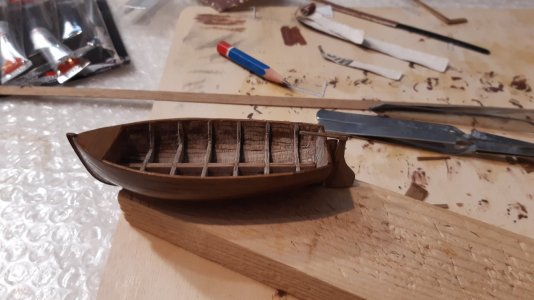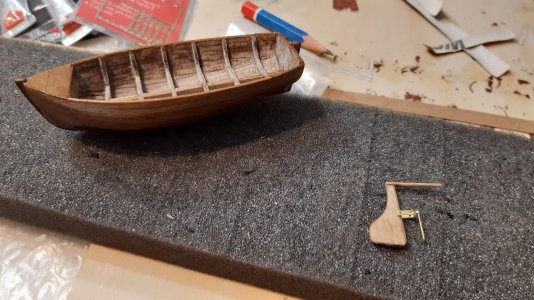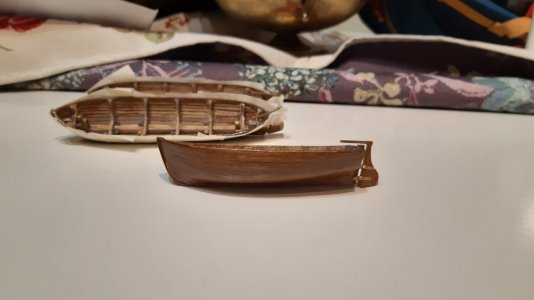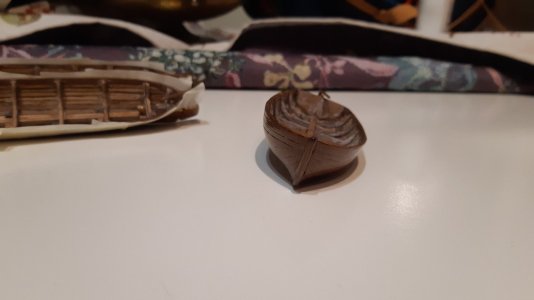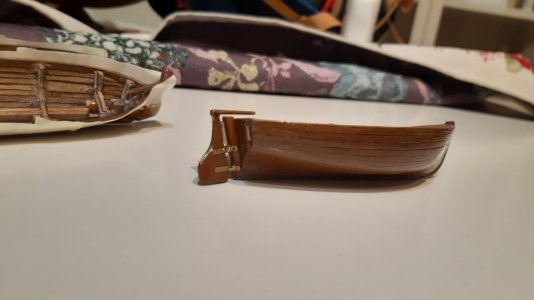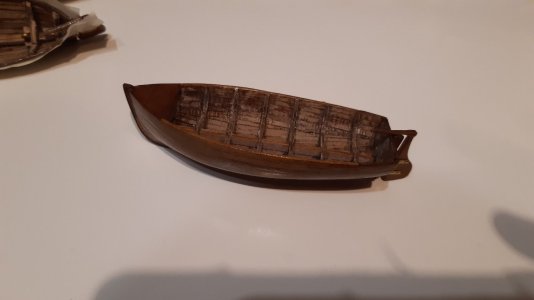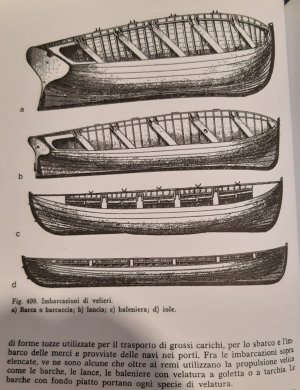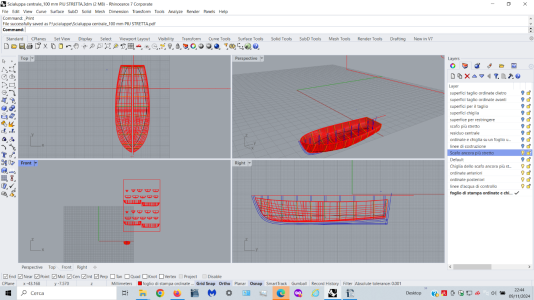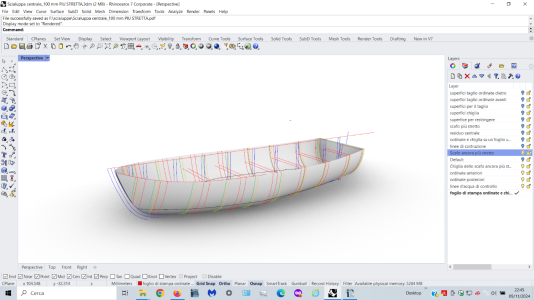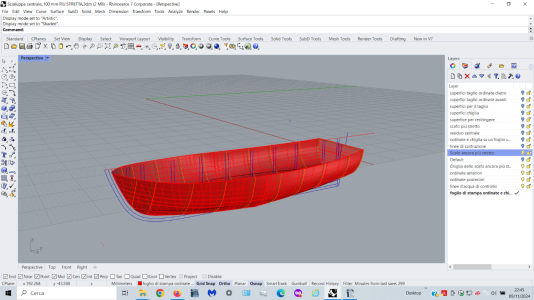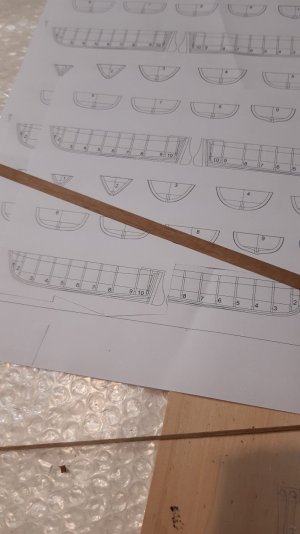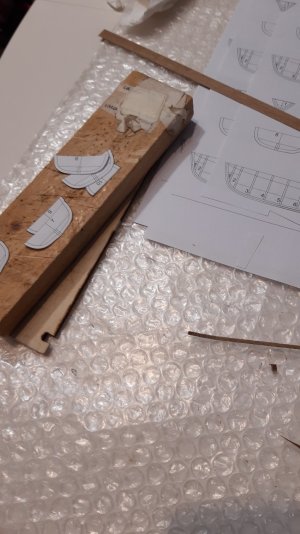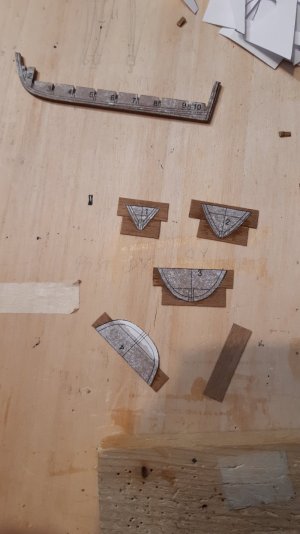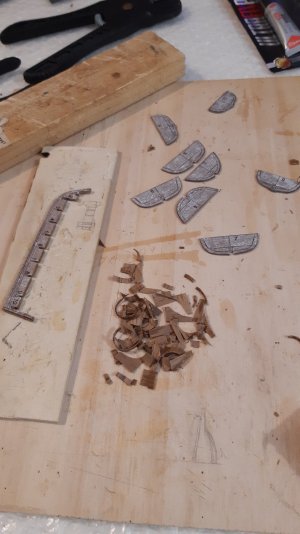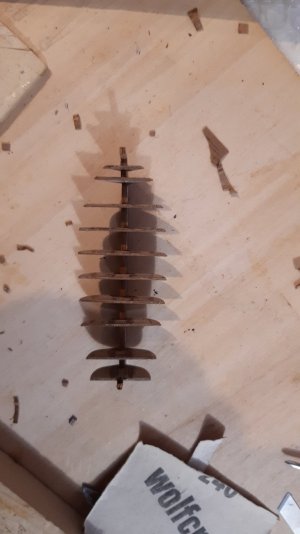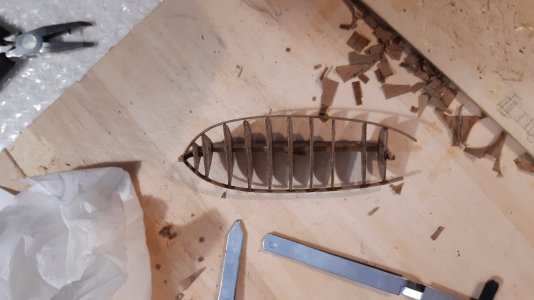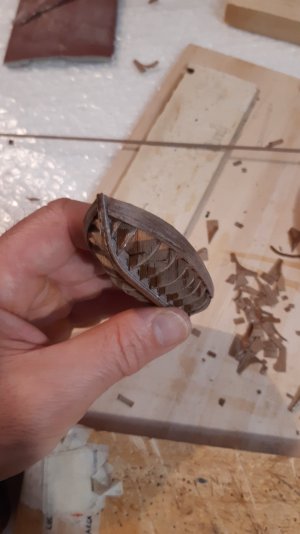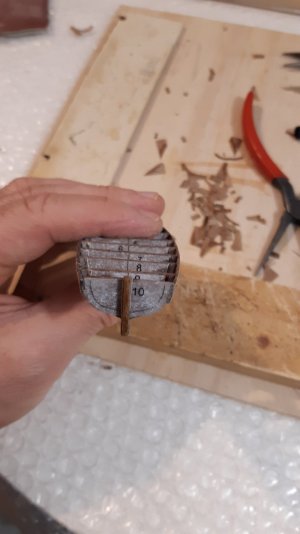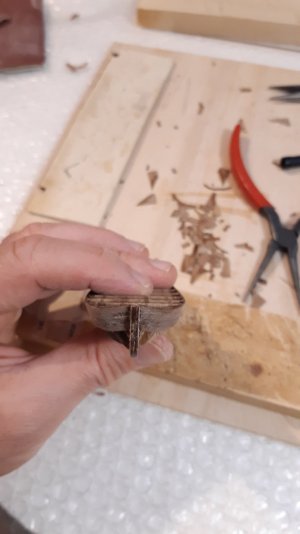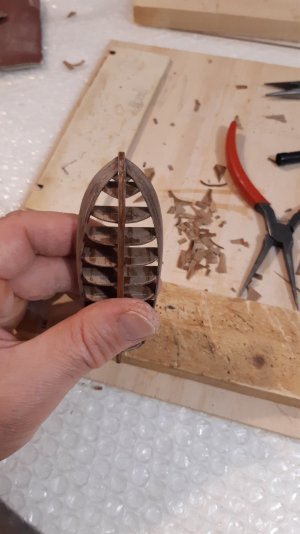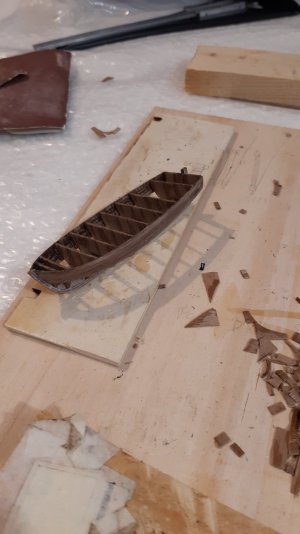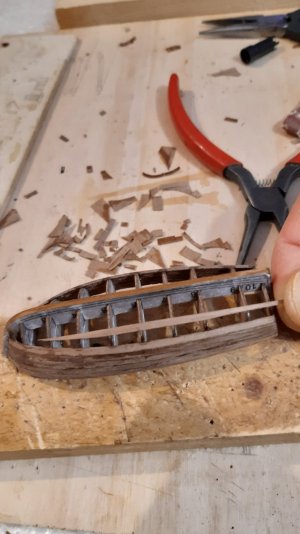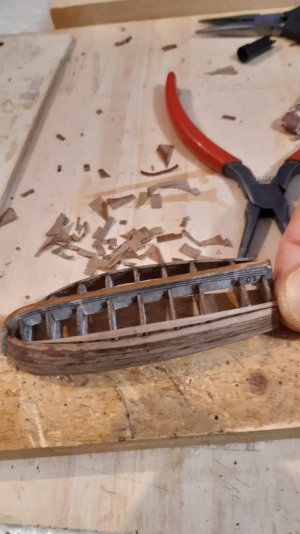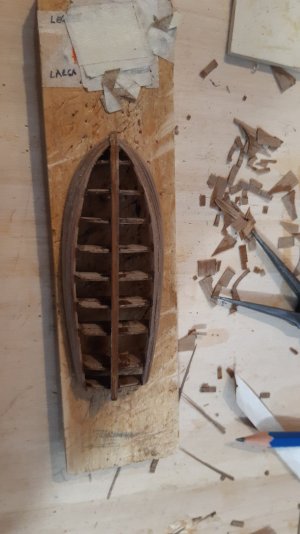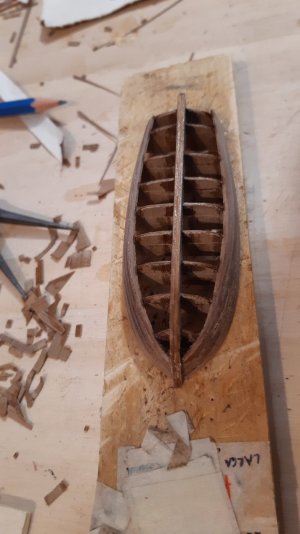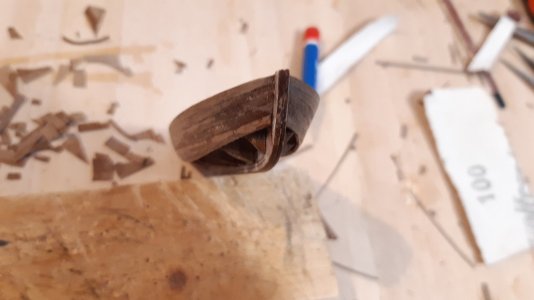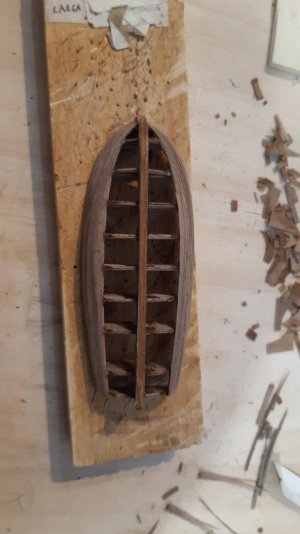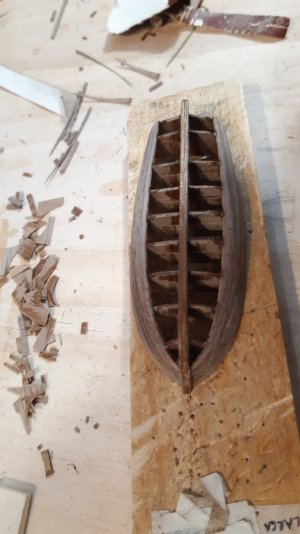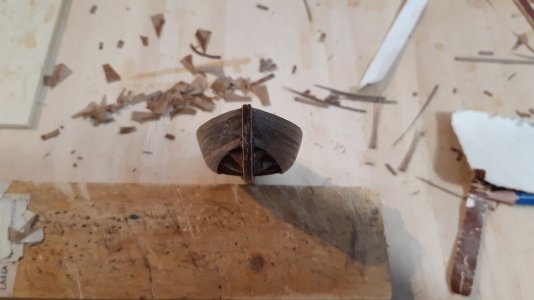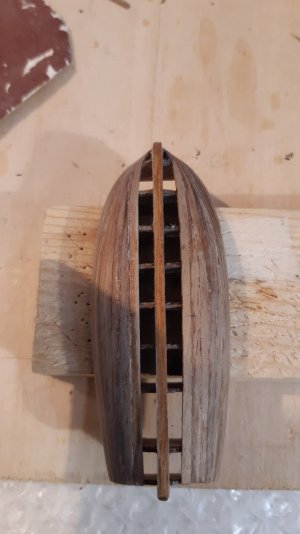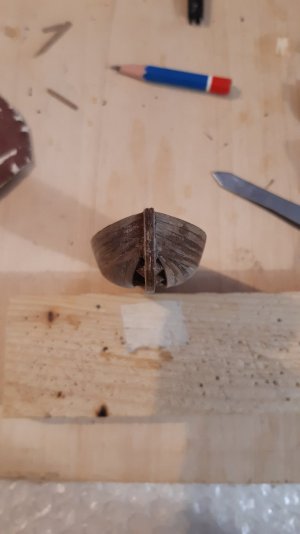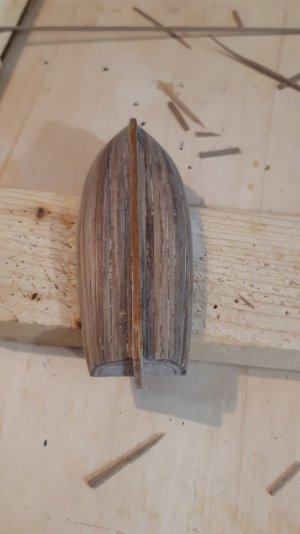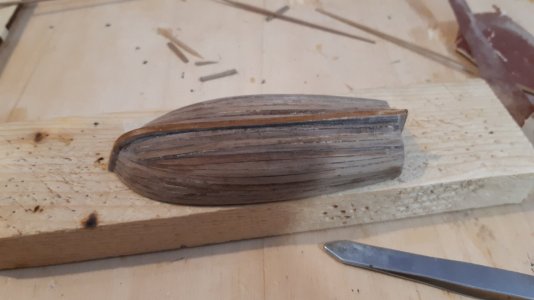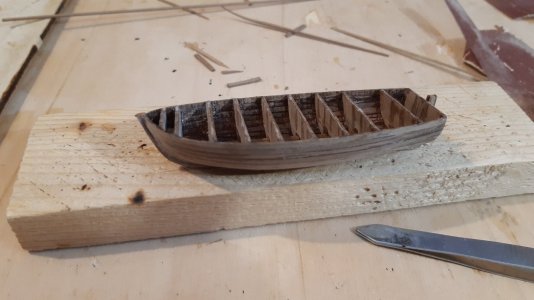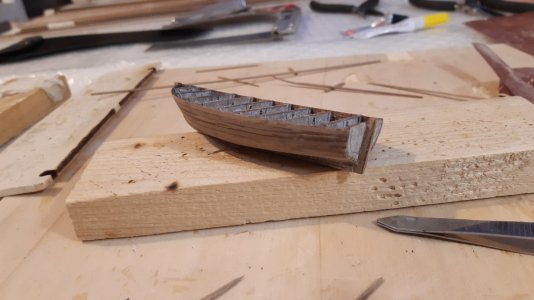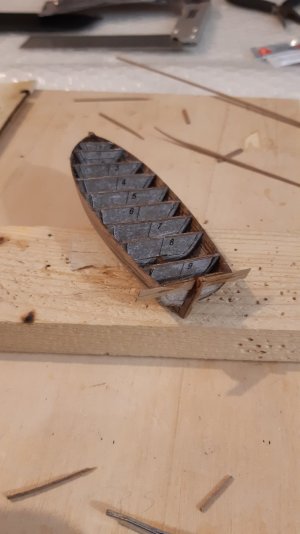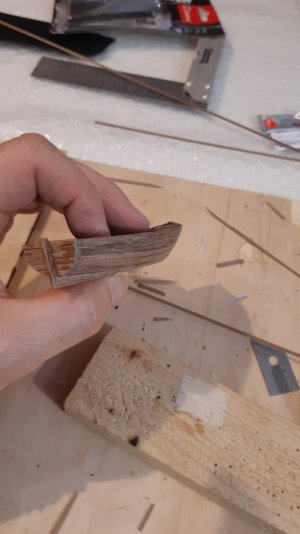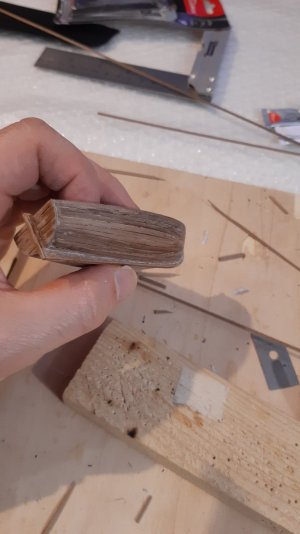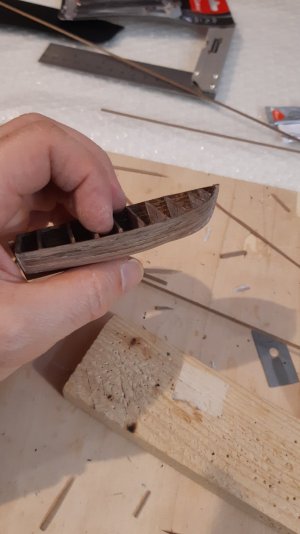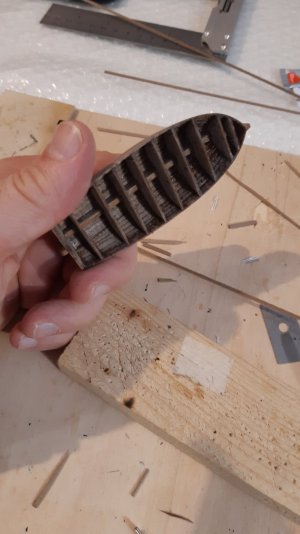- Joined
- Sep 22, 2023
- Messages
- 238
- Points
- 213

Ciao a tutti i modellisti navali.
Ho terminato il primo fasciame della scialuppa.
Nelle foto in sequenza potete osservare le fasi di costruzione.
E' grosso modo lo stesso metodo che uso per le navi.
In questo caso la difficoltà era maggiore a causa delle ridottisime dimensioni.
Ho preferito scegliere listelli larghi 2 mm perchè, nonostante la maggiore difficoltà, erano in scala. 2 mm corrispondono tavole di 12 cm di larghezza (molto coerenti con la realtà).
Mi sono pentito di aver scelto lo spessore di 0,5 mm, troppo poco.
Prima di conoscere e utilizzare la pinza piegalistelli, sceglievo listelli di spessore minimo per avere meno problemi con la curvatura.
Questa vecchia abitudine mi condiziona e mi segue ancora oggi.
Avrei dovuto comprare listelli di spessore da 1 mm (mi avrebbero consetito maggior margine di carteggiatura).
Ora sono indeciso se fare il secondo fasciame o no.
Voi che ne pensate?
Dopo aver carteggiato mi sono reso conto che lo scafo è venuto bene, non ha alcun bisogno di stucco (io non lo uso mai) per correggere avvallamenti o imperfezioni.
Questo va a favore della scelta di non fare il secondo fasciame, inoltre risparmierei tempo prezioso.
Tuttavia lo scafo è veramente leggero ed esile.
I listelli sono molto fini già in partenza (0,5 mm) ma sono stati ulteriormete ridotti con la carteggiatura.
A tenerla in mano fa impressione per quanto è fino lo scafo. Inoltre guardando lo scafo in controluce sembra quasi trasparente.
Attualmente pesa appena 6 grammi ed è lunga 130 cm.
Chi ha seguito la costruzione di questo modello in scala 1:60 fin dall'inizio sa che sono molto attento a posizionare i pesi in alto. le scialuppe dovranno essere molto leggere.
Penso che perderò altro tempo per irrobustire la struttura.
Credo che farò il secondo fasciame e forse resinerò l'interno.
Se la resina epossidica che avevo comprato 12 anni fa non è scaduta (che voi sappiate scadono?) irrobustire gli scafi per me è sempre un'ottima idea.
Senza usare fibra ma spennellando direttamente l'interno dello scafo con la resina epossidica si ottiene un guscio durissimo, molto resistente senza aumentare in maniera aprrezzabile il peso e gli ingombri.
All'esterno userò solo la vernice.
Devo fare ancora il bordo della falchetta, gli scalmi, il paiolato, il timone e i posti a sedere. Sono ancora indeciso se mettere o no il telo di copertura.
Nell'ultima foto si può vedere grosso modo dove andrà collocata la scialuppa (sospesa all'esterno con appositi supporti ricurvi, che mi dovrò studiare).
Hello to all naval modelers.
I have finished the first planking of the lifeboat.
In the sequential photos you can see the construction phases.
It is roughly the same method I use for ships.
In this case the difficulty was greater due to the very small dimensions.
I preferred to choose 2 mm wide strips because, despite the greater difficulty, they were in scale. 2 mm correspond to 12 cm wide boards (very consistent with reality).I regretted having chosen the thickness of 0.5 mm, too little.
Before knowing and using the strip bending pliers, I chose strips of minimum thickness to have fewer problems with the curvature.
This old habit conditions me and still follows me today.
I should have bought 1 mm thick strips (they would have allowed me more margin for sanding).
Now I am undecided whether to make the second planking or not.What do you think?
After sanding I realized that the hull came out well, it does not need any filler (I never use it) to correct depressions or imperfections.
This is in favor of the choice not to make the second planking, also I would save precious time.
However the hull is really light and slender.
The strips are very thin to begin with (0.5 mm) but they were further reduced with sanding.
Holding it in your hand is impressive for how thin the hull is.
Also looking at the hull against the light it seems almost transparent.Currently it weighs just 6 grams and is 130 cm long.
Those who have followed the construction of this 1:60 scale model from the beginning know that I am very careful to position the weights high up.
The lifeboats will have to be very light.
I think I will spend more time to strengthen the structure.
I think I will make the second planking and perhaps I will resin the interior.
If the epoxy resin I bought 12 years ago hasn't expired (do you know if they expire?) strengthening the hulls is always a great idea for me.
Without using fiber but by brushing the inside of the hull directly with epoxy resin you get a very hard shell, very resistant without appreciably increasing the weight and bulk.
On the outside I will only use paint.
I still have to do the edge of the gunwale, the oarlocks, the floorboard, the rudder and the seats.
I'm still undecided whether or not to put the cover sheet.
In the last photo you can see roughly where the dinghy will be placed (suspended on the outside with special curved supports, which I will have to study).
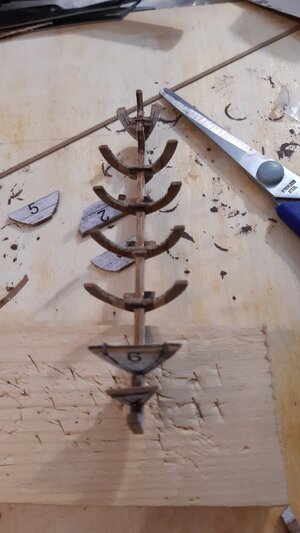
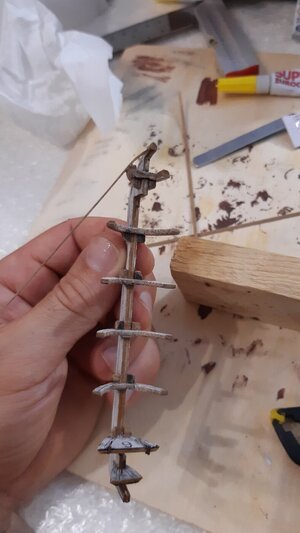
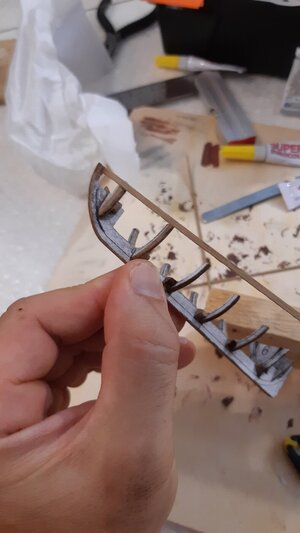
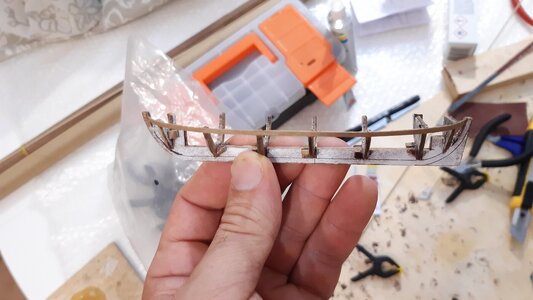
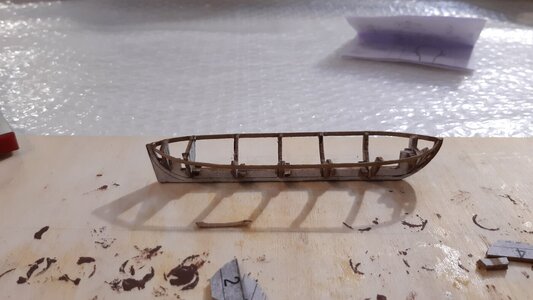
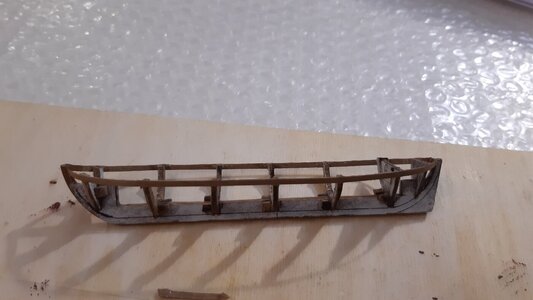
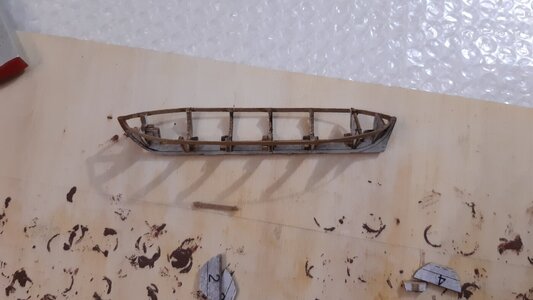
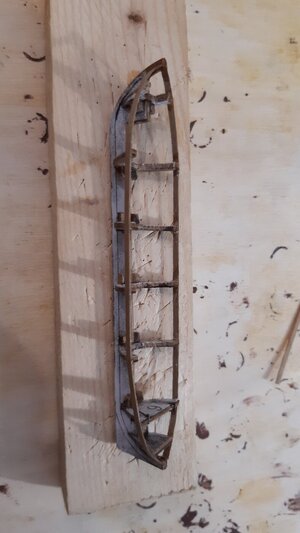
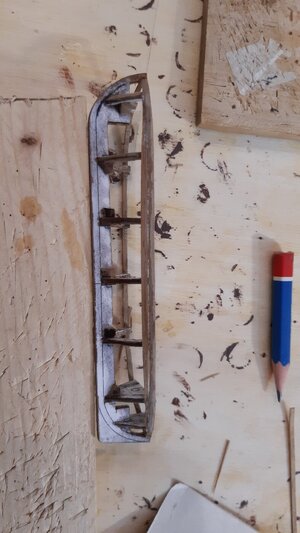

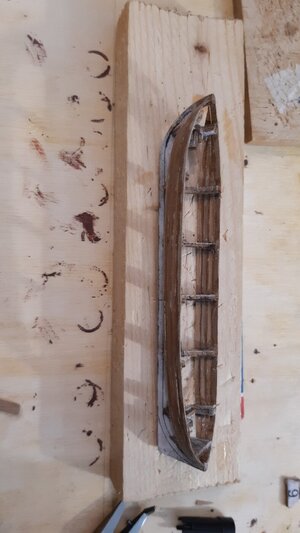
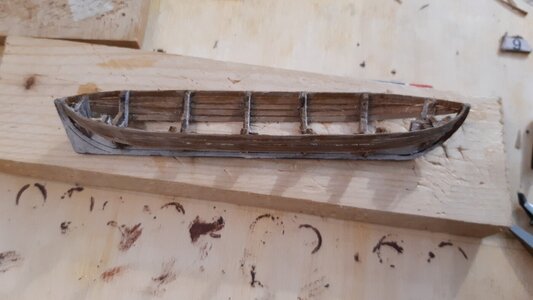
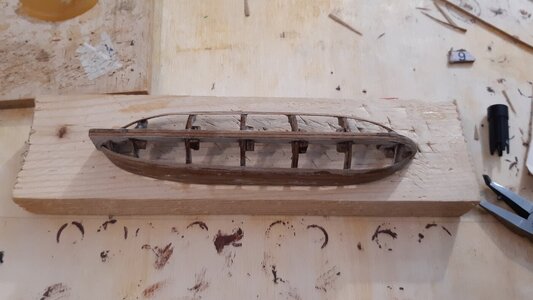


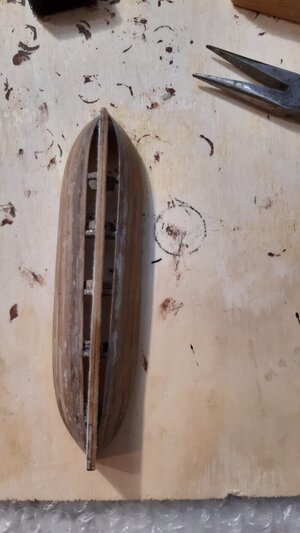
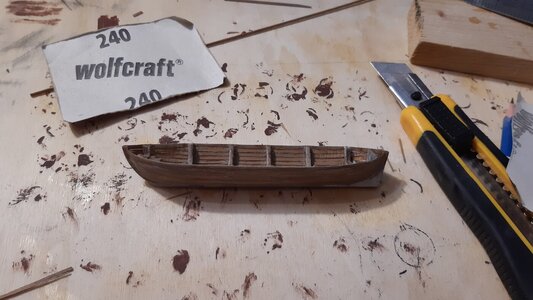

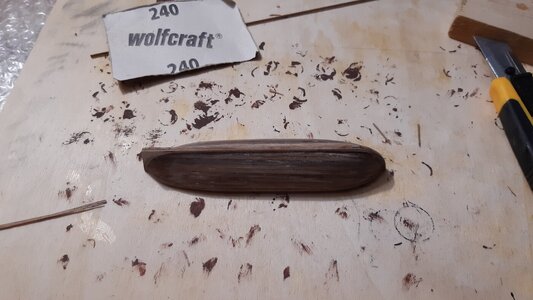
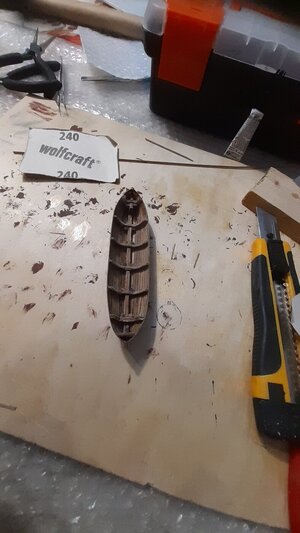
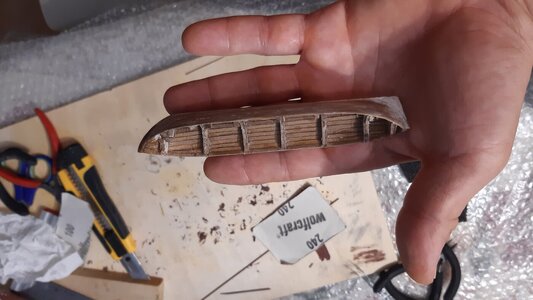
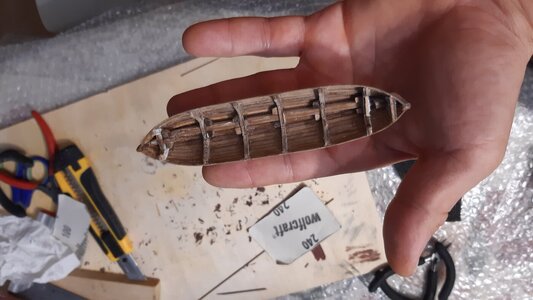

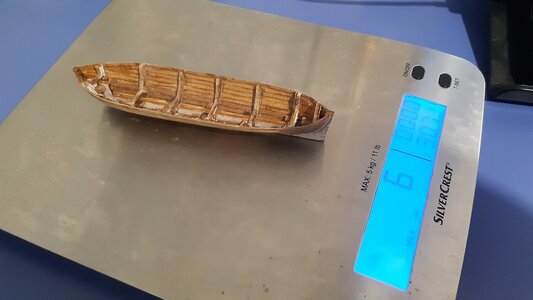
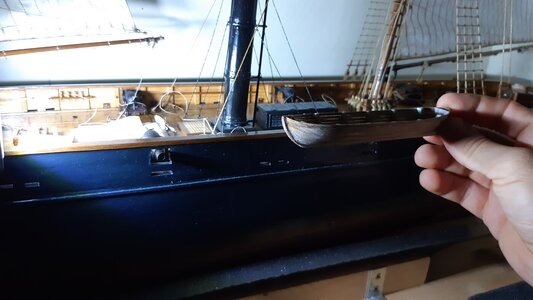
Ho terminato il primo fasciame della scialuppa.
Nelle foto in sequenza potete osservare le fasi di costruzione.
E' grosso modo lo stesso metodo che uso per le navi.
In questo caso la difficoltà era maggiore a causa delle ridottisime dimensioni.
Ho preferito scegliere listelli larghi 2 mm perchè, nonostante la maggiore difficoltà, erano in scala. 2 mm corrispondono tavole di 12 cm di larghezza (molto coerenti con la realtà).
Mi sono pentito di aver scelto lo spessore di 0,5 mm, troppo poco.
Prima di conoscere e utilizzare la pinza piegalistelli, sceglievo listelli di spessore minimo per avere meno problemi con la curvatura.
Questa vecchia abitudine mi condiziona e mi segue ancora oggi.
Avrei dovuto comprare listelli di spessore da 1 mm (mi avrebbero consetito maggior margine di carteggiatura).
Ora sono indeciso se fare il secondo fasciame o no.
Voi che ne pensate?
Dopo aver carteggiato mi sono reso conto che lo scafo è venuto bene, non ha alcun bisogno di stucco (io non lo uso mai) per correggere avvallamenti o imperfezioni.
Questo va a favore della scelta di non fare il secondo fasciame, inoltre risparmierei tempo prezioso.
Tuttavia lo scafo è veramente leggero ed esile.
I listelli sono molto fini già in partenza (0,5 mm) ma sono stati ulteriormete ridotti con la carteggiatura.
A tenerla in mano fa impressione per quanto è fino lo scafo. Inoltre guardando lo scafo in controluce sembra quasi trasparente.
Attualmente pesa appena 6 grammi ed è lunga 130 cm.
Chi ha seguito la costruzione di questo modello in scala 1:60 fin dall'inizio sa che sono molto attento a posizionare i pesi in alto. le scialuppe dovranno essere molto leggere.
Penso che perderò altro tempo per irrobustire la struttura.
Credo che farò il secondo fasciame e forse resinerò l'interno.
Se la resina epossidica che avevo comprato 12 anni fa non è scaduta (che voi sappiate scadono?) irrobustire gli scafi per me è sempre un'ottima idea.
Senza usare fibra ma spennellando direttamente l'interno dello scafo con la resina epossidica si ottiene un guscio durissimo, molto resistente senza aumentare in maniera aprrezzabile il peso e gli ingombri.
All'esterno userò solo la vernice.
Devo fare ancora il bordo della falchetta, gli scalmi, il paiolato, il timone e i posti a sedere. Sono ancora indeciso se mettere o no il telo di copertura.
Nell'ultima foto si può vedere grosso modo dove andrà collocata la scialuppa (sospesa all'esterno con appositi supporti ricurvi, che mi dovrò studiare).
Hello to all naval modelers.
I have finished the first planking of the lifeboat.
In the sequential photos you can see the construction phases.
It is roughly the same method I use for ships.
In this case the difficulty was greater due to the very small dimensions.
I preferred to choose 2 mm wide strips because, despite the greater difficulty, they were in scale. 2 mm correspond to 12 cm wide boards (very consistent with reality).I regretted having chosen the thickness of 0.5 mm, too little.
Before knowing and using the strip bending pliers, I chose strips of minimum thickness to have fewer problems with the curvature.
This old habit conditions me and still follows me today.
I should have bought 1 mm thick strips (they would have allowed me more margin for sanding).
Now I am undecided whether to make the second planking or not.What do you think?
After sanding I realized that the hull came out well, it does not need any filler (I never use it) to correct depressions or imperfections.
This is in favor of the choice not to make the second planking, also I would save precious time.
However the hull is really light and slender.
The strips are very thin to begin with (0.5 mm) but they were further reduced with sanding.
Holding it in your hand is impressive for how thin the hull is.
Also looking at the hull against the light it seems almost transparent.Currently it weighs just 6 grams and is 130 cm long.
Those who have followed the construction of this 1:60 scale model from the beginning know that I am very careful to position the weights high up.
The lifeboats will have to be very light.
I think I will spend more time to strengthen the structure.
I think I will make the second planking and perhaps I will resin the interior.
If the epoxy resin I bought 12 years ago hasn't expired (do you know if they expire?) strengthening the hulls is always a great idea for me.
Without using fiber but by brushing the inside of the hull directly with epoxy resin you get a very hard shell, very resistant without appreciably increasing the weight and bulk.
On the outside I will only use paint.
I still have to do the edge of the gunwale, the oarlocks, the floorboard, the rudder and the seats.
I'm still undecided whether or not to put the cover sheet.
In the last photo you can see roughly where the dinghy will be placed (suspended on the outside with special curved supports, which I will have to study).





























